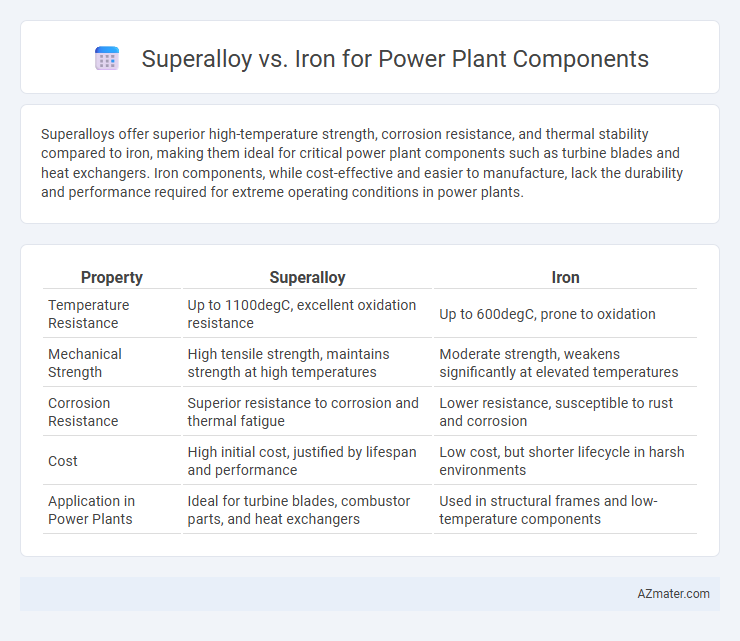Superalloys offer superior high-temperature strength, corrosion resistance, and thermal stability compared to iron, making them ideal for critical power plant components such as turbine blades and heat exchangers. Iron components, while cost-effective and easier to manufacture, lack the durability and performance required for extreme operating conditions in power plants.
Table of Comparison
| Property | Superalloy | Iron |
|---|---|---|
| Temperature Resistance | Up to 1100degC, excellent oxidation resistance | Up to 600degC, prone to oxidation |
| Mechanical Strength | High tensile strength, maintains strength at high temperatures | Moderate strength, weakens significantly at elevated temperatures |
| Corrosion Resistance | Superior resistance to corrosion and thermal fatigue | Lower resistance, susceptible to rust and corrosion |
| Cost | High initial cost, justified by lifespan and performance | Low cost, but shorter lifecycle in harsh environments |
| Application in Power Plants | Ideal for turbine blades, combustor parts, and heat exchangers | Used in structural frames and low-temperature components |
Introduction to Power Plant Materials
Power plant components require materials that withstand extreme temperatures, high pressure, and corrosive environments, making superalloys and iron critical choices. Superalloys, primarily nickel, cobalt, or iron-based, offer superior creep resistance, oxidation resistance, and mechanical strength at elevated temperatures compared to traditional iron-based materials. Although iron excels in cost-effectiveness and availability, superalloys dominate in advanced power plant applications such as turbine blades and heat exchangers due to their enhanced durability and performance under severe operating conditions.
Overview of Superalloys
Superalloys are advanced high-performance materials designed to withstand extreme temperatures, mechanical stress, and corrosive environments in power plant components. Composed primarily of nickel, cobalt, or iron, these alloys exhibit exceptional strength and oxidation resistance, making them ideal for turbine blades, heat exchangers, and combustion chambers. Their superior thermal stability and creep resistance provide significant advantages over conventional iron-based materials in enhancing power plant efficiency and longevity.
Key Properties of Iron
Iron offers excellent thermal conductivity and magnetic properties essential for power plant components subjected to fluctuating electromagnetic fields. Its high tensile strength and ease of fabrication enable efficient manufacturing of large structural parts. While iron has lower corrosion resistance compared to superalloys, protective coatings can enhance its durability in high-temperature, oxidizing environments.
Mechanical Strength Comparison
Superalloys exhibit superior mechanical strength compared to iron, especially at elevated temperatures commonly found in power plant components. Their high tensile strength, creep resistance, and fatigue life outperform iron and iron-based alloys, ensuring enhanced durability and reliability under thermal and mechanical stress. This makes superalloys the preferred choice for critical components such as turbine blades and heat exchangers where mechanical integrity is crucial.
Corrosion and Oxidation Resistance
Superalloys exhibit superior corrosion and oxidation resistance compared to iron, making them ideal for power plant components exposed to high temperatures and aggressive environments. Their ability to maintain structural integrity under oxidative stress significantly reduces maintenance costs and extends component lifespan. Iron, while cost-effective, tends to oxidize and corrode more rapidly, limiting its durability in harsh power plant conditions.
Thermal Stability and Performance
Superalloys exhibit superior thermal stability and performance compared to iron in power plant components, with operational temperatures often exceeding 700degC while maintaining mechanical strength and oxidation resistance. Their advanced composition, including elements such as nickel, chromium, and cobalt, provides enhanced creep resistance and corrosion protection under extreme thermal conditions. Iron-based alloys generally have lower melting points and reduced thermal fatigue resistance, limiting their effectiveness in high-temperature environments typical of power generation systems.
Durability and Lifespan in Harsh Environments
Superalloys exhibit superior durability and extended lifespan compared to iron when used in power plant components exposed to harsh environments, thanks to their enhanced resistance to high temperatures, oxidation, and corrosion. The complex microstructure of nickel-based superalloys maintains mechanical strength and creep resistance under extreme thermal and mechanical stress, outperforming iron alloys that tend to degrade more rapidly. Consequently, selecting superalloy materials for turbines, boilers, and heat exchangers significantly improves operational efficiency and reduces maintenance frequency in demanding power generation settings.
Cost and Availability Considerations
Superalloys, primarily composed of nickel, cobalt, and chromium, exhibit superior high-temperature strength and corrosion resistance compared to traditional iron-based alloys, making them ideal for power plant components exposed to extreme conditions. However, superalloys are significantly more expensive and less abundant than iron, impacting the overall cost and procurement timelines for power plant projects. Iron and its alloys offer greater availability and lower material costs, though they may require more frequent maintenance or replacement due to lower performance in high-temperature environments.
Applications in Power Plant Components
Superalloys offer superior high-temperature strength, corrosion resistance, and oxidation stability, making them ideal for turbine blades, heat exchangers, and boiler components in power plants. Iron-based alloys, including various steels, are commonly used in structural parts such as piping, pressure vessels, and casings due to their cost-effectiveness and good mechanical properties. The selection depends on operational temperature ranges and exposure to corrosive environments, where superalloys excel in extreme conditions while iron-based materials suit moderate-temperature applications.
Final Verdict: Superalloy or Iron for Power Plants?
Superalloys offer superior oxidation resistance, high-temperature strength, and long-term durability compared to iron, making them ideal for critical power plant components exposed to extreme conditions. Iron, although more cost-effective, lacks the corrosion resistance and mechanical properties required for efficient and reliable operation in high-temperature environments. For power plants prioritizing performance, longevity, and safety, superalloys represent the optimal choice despite their higher initial cost.

Infographic: Superalloy vs Iron for Power Plant Component
 azmater.com
azmater.com